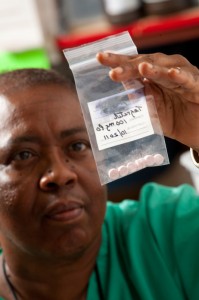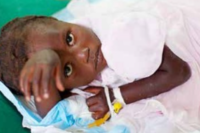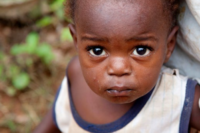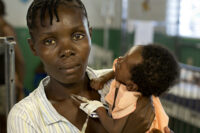In Haiti the decision to live or die often depends upon seemingly simple things, such as the availability of an antibiotic to administer to a patient, or the availability of oxygen for a patient in respiratory distress. Hôpital Sacré Coeur in Milot continually strives to provide the population it serves with quality care. After January 12th, we were ready to help victims of the earthquake that were coming from Port au Prince and many other regions in Haiti. Three days after this catastrophe, our position as a referral hospital had expanded and we had to face new challenges that require a lot of knowledge, expertise and resources.
Fernande’s story is one among many success stories that prove once again that unity is strength. This patient is still alive because men and women of different races, different religions, and different occupations combined their differences to become a Team; a team focused on keeping this woman alive.
Clinical Presentation:
Fernande Elie, a 63 year-old woman who is diabetic and obese, sustained a wound necrosis bilateral BKA Stumps after bilateral supra-condylar amputation was done on the 13th of January 2010. She is a quake victim whose house collapsed while she was cooking for her children. Fernande Elie was taken to another hospital before arriving at Hôpital Sacé Coeur on the 24th of January. Fernande presented with conjunctivae pale, III/VI SEM apex…..axilla, L stump with bandage, R stump with suture and small areas of drainage. Her blood pressure was high. She also presented with dyspnea and crackles in the lungs. Fernande Elie initially presented with sepsis and dehydration upon admission to Hôpital Sacé Coeur ICU.
Non-Medical Translation:
Fernande Elie, 63, sustained severe crush injuries to her legs when her house collapsed during the earthquake. Fernande already had difficult health problems. She is diabetic and very overweight. Her body was not in the best of shape to take on additional stress. On January 13, both of Fernande’s legs were amputated just below the knees. Her wounds did not continue to heal well. Her legs were further amputated to above the knees. By the time she arrived at Hôpital Sacré Coeur, Fernande was in critical condition. Her stump wounds were infected and draining. Her heart was beginning to fail because of a very badly leaking heart value which meant that her heart was having a difficult time pumping blood in the proper direction. In an interesting turn of events, she also had high pressure, an unexpected condition that placed additional strain on her heart. As if that was not enough for Fernande to deal with, her breathing was labored, her lungs had filled with fluid and, Fernande’s body was being overwhelmed by infection. Her life was most definitely in danger.
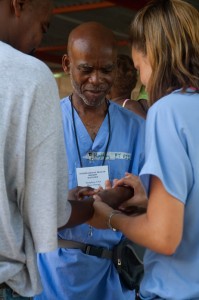 The following diagnosis was adopted:
The following diagnosis was adopted:
1-AKA with stump wound (Above the Knee Amputation)
2-HTN +Cardiac heart failure (Fernande was hypertensive and in heart failure)
3-Non insulin dependent diabetes (NIDD) (Fernande was diabetic)
Fernande underwent deep debridement with IV sedation in OR on 01/31/10. She received large doses of antibiotics and heparin. In addition to the surgical measures, she benefitted from a medical treatment alternately made of lisinopril, amlodipine, coreg, ASA, furosemide, prilosec, morphine, and labetolol.
(The medical team took Fernande to the operating room and cleaned her leg wounds. She was then given a standard protocol of medications to fight off infection, slow her heart down, get the extra fluids out of her system, open up her blood vessels so it was easier for her heart to pump and direct blood flow and to control her pain.)
Five days later, Fernande became highly febrile, aphasic, and breathed uneasily. She was then placed on a ventilator. After five days, she felt better but still presented with some dyspnea and fever. Then, the ventilator was stopped, replaced by 02 per canula. She was left there during more than 30 days with an aggressive treatment for her pneumonia and cardiac heart failure.
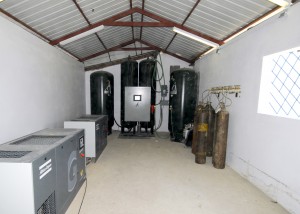 (Fernande became feverish, was not able to speak and had difficulty breathing. She had developed pneumonia. A small stroke was a possible explanation for her speech difficulty, perhaps the result of a thrown blood clot or maybe from the release of pus from her lungs. She was placed on a respirator and her condition improved. Finally, she had improved enough to be taken off the ventilator and receive oxygen through small breathing tubes.)
(Fernande became feverish, was not able to speak and had difficulty breathing. She had developed pneumonia. A small stroke was a possible explanation for her speech difficulty, perhaps the result of a thrown blood clot or maybe from the release of pus from her lungs. She was placed on a respirator and her condition improved. Finally, she had improved enough to be taken off the ventilator and receive oxygen through small breathing tubes.)
Fernande underwent revisions of her BKA stumps on 03/09/10, 03/19/10, and 03/25/10.
No matter where Fernande was in Haiti, including Milot, two weeks before the earthquake, she would have died. She was fortunate to be transferred to the right hospital at the right time. A young Haitian surgeon, who now lives in Boston but returned to Milot to volunteer, and a nurse anesthetist, with experience in how to manage patients on respirators, decided to do whatever was needed to take care of Fernande while she was in the Intensive Care Unit.
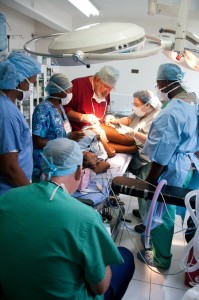 Fernande brushed against death many times and finally she was placed on a respirator for 5 days, which allowed her to still be alive today.
Fernande brushed against death many times and finally she was placed on a respirator for 5 days, which allowed her to still be alive today.
She thus became the first patient in Haiti to be kept on a respirator for so long and to survive.
This was a team effort and required the solidarity of a lot of people, especially Phillips Medical that gave us the latest generation of respirators. Working together as a team, the volunteers and the local staff at the hospital applied their expertise to the care of the patient. Together they helped Fernande to continue to enjoy this precious gift that is LIFE.


